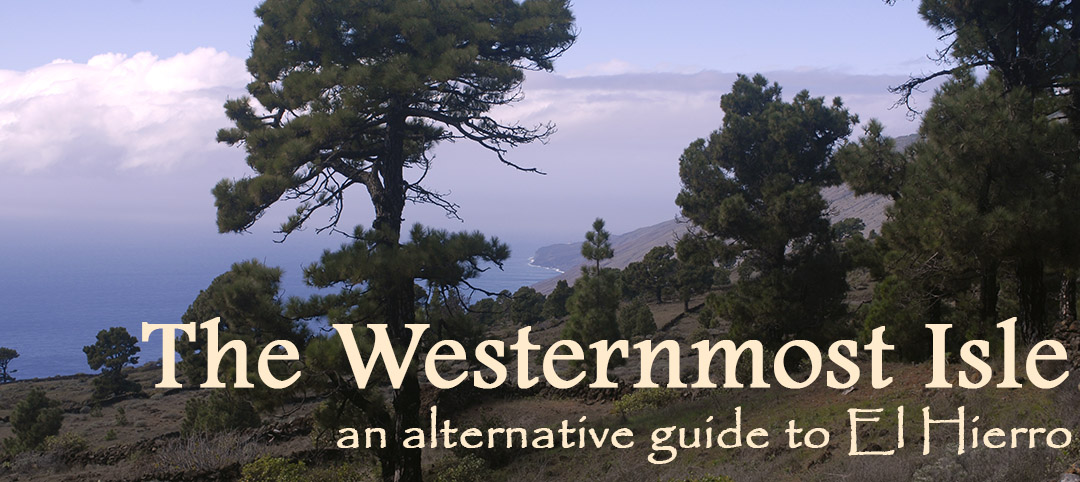Some sixty years ago, enterprising farmers from La Palma decided to set up banana plantations in El Hierro. The idea was to truck down from the central highlands fertile soil with which to cover the volcanic badlands at sea level in El Golfo. Some of this earth was just tipped over the edge of the surrounding cliffs. Walls were built to encompass the future plantations and wells dug to supply irrigation. But the island has a mind of its own and the Palmeros had not counted on the wind, the wicked wind, fatal to banana plants. The Palmeros cut their losses and left, leaving all their investment to the rejoicing Herreños. Gradually the new agricultural land was reconverted to other, less susceptible but more profitable, tropical fruit crops. Bananas are still grown in El Golfo, mostly in greenhouses, while the main single producer is an enormous greenhouse in the south of the island.

Hundreds of steel posts form the structure of this enormous greenhouse measuring 120,000 square metres, or
30 acres, covered with fine mesh netting to protect the banana plants from the wind and insects. The lorry
and wharehouse on the left give an idea of the size. I find the geometric austerity of the greenhouse somehow
fits in well with the cruel beauty of this desolate landscape in the south of the island.
The area of El Golfo produces excellent pineapples and fibreless mangoes, called ‘mangas’ here in opposition to the smaller fibrous kind. Most of the production of bananas and pineapples is exported to mainland Spain, and mangoes to the other islands. Pawpaws and other exotic fruits are also grown.
Terraces of pineapples. Notice the cruel points have been cut off the leaves to spare the workers on these dense
plantations. The shaddows of 15 foot banana plants show up against the netting on the side of the greenhouse on
the left. The earth for these terraces built on the volcanic badlands may well have been tipped over the 3,000 ft
cliffs in the background.
All of these tropical and subtropical fruit are, of course, relative newcomers to the island. Historically the most important fruit crop in the island was the grape for wine and brandy. And it is gradually making a comeback. Several posts in this blog discuss our viticulture and wines.
Another fruit is the prickly-pear. It seems to have declined in grace in recent years. The cactus it grows on was once farmed in all the Canary Islands for the carmine dye of the cochineal insect that infests the paddles and was used to colour Campari, Moroccan flowerpot hats, lipstick ...
Post 31 in this blog is all about figs. The ubiquitous fig trees are extremely hardy, long-lived and drought resistant and so thrive particularly well on the southeastern slopes around El Pinar, as do almond trees.
Almond trees blossom sometime between Christmas and the end of February and El Pinar is dressed in all tones from white to blushing pink. We know one Scandinavian couple who passed through the village while on holiday and were so enchanted by the spectacle they came to live here. Some say the pinker the blossom the more bitter the nut, but in my experience that is not so. One kind of almond I had never seen before is the ‘mollar’ (pronounced ‘moyAR’), meaning ‘soft’ in reference to the husk and shell which you can separate from the nut with your fingers. Like figs, almonds were once important to the countryman’s subsistence economy, but now California produces them cheaply and you don’t even have to shell them! Nevertheless, in late summer we wake up to the dry “tap tap” of nostalgic old women (and sometimes men) beating the almond trees with long poles to gather the nuts.
Most fruit trees you can buy today are on dwarfing stock for ease of picking. These have by nature very superficial roots and so do not flourish under our conditions of poor rainfall and sandy soil. But an almond tree grown from seed has a good root system, including a very long taproot. So here it has proved an excellent rootstock on which to graft other drupes, like peaches, nectarines, apricots, plums … All of these are grown locally for home consumption.
The russet apples, called ‘Reinetas’, from San Andrés were very much appreciated. Undeservedly so in my opinion. But their production is now barely testimonial,
presumably by being priced out of the market and/or climate change. We
have found that one pome fruit (of the same family as an apple) that
does well here with a little irrigation is the quince. It produces large
fruit that ripen in autumn and make a very good jelly. Incidentally, the word ‘marmalade’ appears to
derive from the Portuguese word ‘marmelo’ meaning ‘quince’.
Citrus fruit, despite there being a lemon tree in nearly every house’s
kitchen garden, demand too much water. In Frontera there were, a few
years ago, several plantations of oranges, most of which have been
abandoned. They could not compete with imports from Valencia, and now
Morocco.
Given the variety and quality of the fruit that grows on the island you would expect some sort of secondary industry such as the production of jam, even on a limited scale, to be successful. But it is not easy to deal with EU rules – devised to favour large manufacturers – nor the idiosyncrasy of established distribution networks ... Never worry! At home we always have a good supply of delicious jam, deep-frozen plums and apricots, fresh pineapple, pawpaws, seasonal mangoes, homemade wine …!








